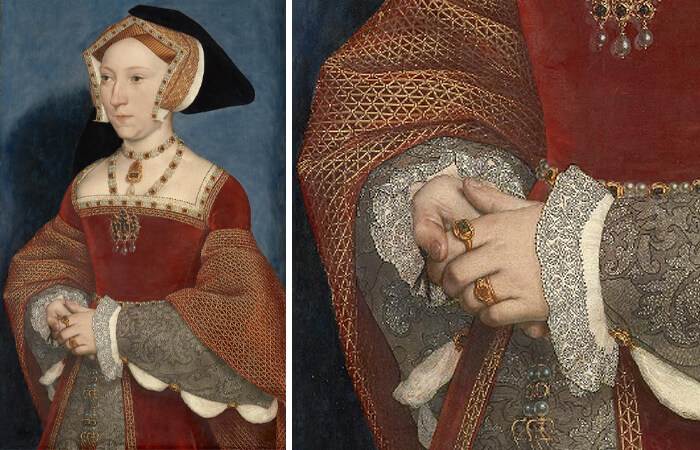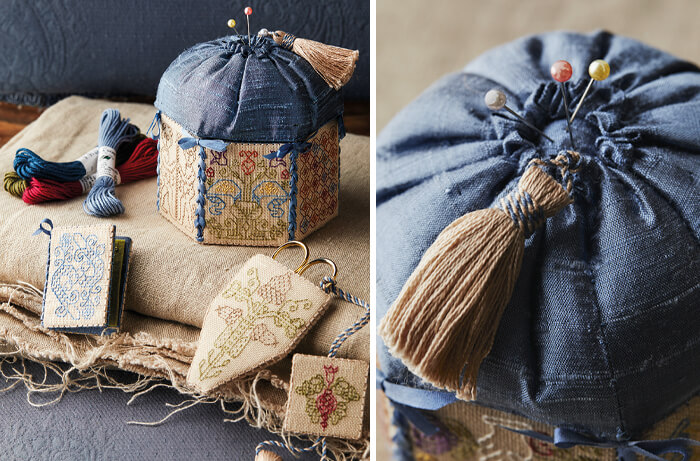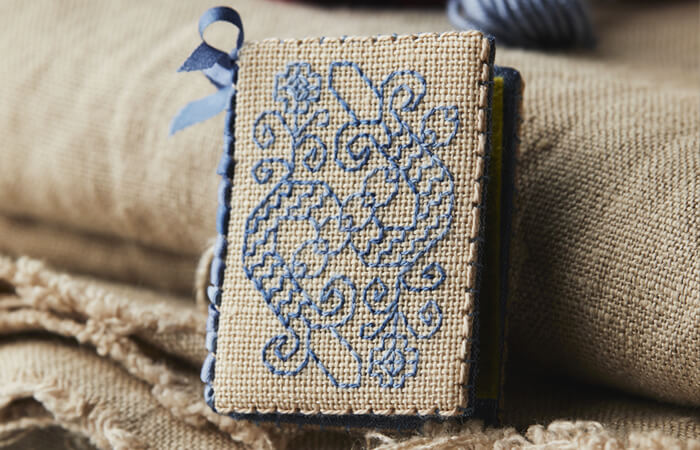Holbein Hexagon Etui by Betsy Morgan
25th February 2022
Blackwork is a counted embroidery technique that has been practiced since Tudor times. It was traditionally worked with black thread on white fabric and included intricate patterns and motifs. Blackwork can be stitched in several ways.

For items that do not need to be reversible, back stitch is a perfectly legitimate way to stitch it. However, it was often used on clothing, which meant both the front and the back of the stitching could be seen. In this situation, a different stitch was required.

Portrait of Jane Seymour (source)
Reversible blackwork is worked in double running stitch or Holbein stitch. This is a method of stitching that allows the back of the work to look almost exactly the same as the front. The term ‘Holbein stitch’ came from the painting of Jane Seymour by Hans Holbein. In this portrait, Jane’s two cuffs on her jacket are stitched in blackwork, but on her left wrist, you can see the outside of the stitching and on her right, you can see the inside.
Doing reversible blackwork requires thought as to the path that your needle takes, and this particular puzzle is one that designer Betsy Morgan is passionate about.
She loves the process of determining how to create the motif, using running stitch up one way and back the other, resulting in perfect mirroring of both sides of the stitching.

When Betsy was designing the Holbein Hexagon Etui as featured in her latest book Willing Hands 2, she knew it was going to be one of her final designs before retiring from teaching. She wanted to use her favourite stitch, as well as create an etui in an interesting shape inspired by an antique container she saw at the Pioneer Memorial Museum in Salt Lake City, Utah, USA.

Although this design can be worked using backstitch as the back of the stitching won’t be visible once the etui is made up, Betsy really encourages stitchers to try Holbein stitch.
The final effect is slightly different – double running stitch results in a smoother line.
But Betsy would also like everyone to share in the pleasure of the puzzle that comes from seeing if you can achieve a fully reversible design.

Like most of Betsy’s projects, this one is beautifully coloured, with a dusty blue silk setting off the finished piece, and the motifs worked in a range of colours.

The tiny accessories that fit inside the main etui include a scissor sheath, fob and needlebook and the whole ensemble is held together with ribbon and studded with little stitched details throughout.

The pleasure of the stitching journey should be just as great as the satisfaction in the finished piece. By seeing if you are able to complete the Holbein Hexagon Etui with the stitch Betsy suggests, you are ensuring that the journey is filled with problem solving, fun and an intense sense of achievement once it is complete.

Whether you want to stitch this project because you love how it looks, or because you want to join in with the celebration of Betsy’s amazing teaching career culminating in this outstanding etui, you’ll come out of the process with more skills and more confidence in your stitching than you’ve ever had before.
Make Your Own Holbein Hexagon Etui

Step 1 – Purchase Project Instructions
Holbein Hexagon Etui by Betsy Morgan is a hexagon box with silk pincushion lid showcasing Betsy’s favourite stitching technique with Tudor-inspired motifs.
Willing Hands 2
Step 2 – Purchase Ready-To-Stitch Kit
The Inspirations Ready-To-Stitch kit for Holbein Hexagon Etui includes everything* you need to re-create this enchanting etui: Fabrics (unprinted), interfacings, interlining, comic board, wool felt, beading thread, sewing thread, embroidery threads, ribbon and needles.
Holbein Hexagon Etui – WH2 Kit
*Please Note: To cater for flexibility of purchase, instructions are not included with our kits. For step-by-step directions on how to create this project, please refer to the book.
